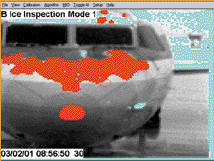Brent D. Johnson, Senior News Editor
One of the greatest hazards to aviation is ice buildup on the control surfaces of an aircraft. If the ice is in front of an engine, it can be ingested during takeoff, causing a flameout. Ice also changes the aircraft's handling characteristics.

Near-infrared photodetector arrays are key elements of an aircraft ice-detection system.
The state of the art in ice detection is not very technical. MD-80s, 737s and smaller planes undergo tactile testing -- ground crews actually touch the aircraft. Larger aircraft are inspected visually, with crews using poles to poke and prod some locations.
Cox & Co. Inc. of New York has developed a device that, if approved for commercial use, could change routine ice inspection. The Contamination Detection System is a passive near-infrared device that uses three narrow bandpasses in the 1- to 1.5-µm range to detect the presence of ice.
The system compares the relative intensity of light before it reaches the target and as it returns. An incandescent light enables nighttime detection.
Crews watch a monitor that shows gray-scale images of the aircraft, with icy areas showing up in red. The system can detect ice layers of 0.5 mm or thicker from as far as 65 feet away.
The company makes its own cameras, including the electronics, but it turned to Sensors Unlimited for the crucial InGaAs photodetector arrays. The choice was entirely practical: When Cox's engineers were developing the prototype, Sensors Unlimited was the only company that came forward to supply the required near-infrared area arrays.
Cox tested the system last winter at the central deicing facility at Toronto Airport.